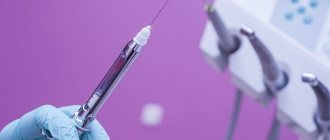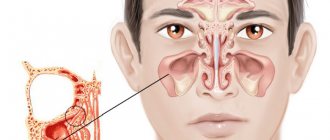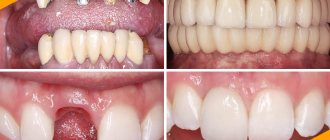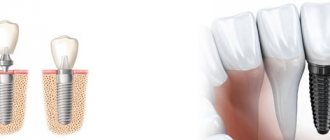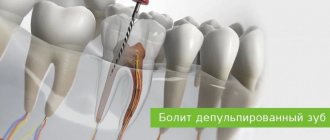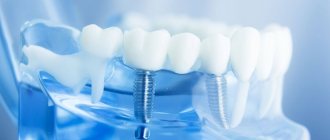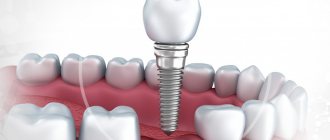How does an infection in a tooth cause the lining of the maxillary sinus to thicken?
The apices of the roots of the teeth are located under the Schneiderian membrane, that is, under the mucous membrane that lines the bottom of the maxillary sinus.
This is the normal anatomical structure of the sinus - when the tops of the teeth are located in it. Some people have the tops of the fourth, fifth, sixth, seventh there. Some people only have the sixth. Some have sixth and fifth. But, one way or another, they are almost always there.
When a tooth is affected by caries, the infection penetrates through the dentinal tubules into the pulp chamber. Through it, the infection slowly progresses further through the blood and lymphatic vessels into the periodontium of the tooth.
Pulp microvessels emerge from the periodontium directly under the mucous membrane of the sinus, and over time it begins to react with inflammation.
Immune system cells responsible for protecting against infection initiate chronic inflammation. And the mucous membrane gradually thickens. This irritation happens all the time.
Infection from the carious process, which is thus restrained by immunocytes, causes a gradual degeneration of the structure of the sinus lining in the form of polyps and cysts.
Acute and chronic odontogenic sinusitis
This form of sinusitis is quite painful. This occurs due to the connection between the acute form and inflammation in the area of the tooth root. However, if there are always persistent dental problems, acute sinusitis can develop into chronic inflammation of the antral sinus. The two forms of sinusitis differ in their symptoms.
Acute dental sinusitis manifests itself:
- Severe throbbing pain;
- Swelling around the cheek (can reach up to the eyelid);
- Redness of the nasal wall and turbinates;
- Secretion from the nose is mucopurulent in nature.
In addition, pressing on the affected area may cause pain. Acute dental sinusitis is usually accompanied by fever.
Signs of the chronic form of odontogenic sinusitis are often much less pronounced. Some patients experience symptoms only occasionally, such as occasional headaches.
Can a dentist diagnose sinusitis?
In case of pulpitis, the patient finally comes to the dentist. The doctor fills the canals, removes the nerve, but part of the infection still remains in the apical delta - after all, it has penetrated there a long time ago!
The apical delta is a branching at the tips of the roots that can never be adequately sterilized. And if a tooth has many roots, then, naturally, the entire system of root canals is one, like the root of one tree.
Therefore, if an infection gets into a tooth, it is already inside.
And it’s normal that the body fights it, and the sinus mucosa begins to thicken. In the process, some people develop granulomas, others - cysts. But cysts are changes in the periodontium, and the mucous membrane itself begins to thicken and degenerate.
Sometimes it happens that polyps are formed - spherical thickenings on a stalk. Hypertrophy of the columnar epithelium may occur. That is, as a result of chronic inflammation, many, many layers are formed.
The dentist can conduct a computed tomography scan, but it can only identify changes in the mucous membrane in volume - simply establish the presence of this fact.
And only an otolaryngologist can say what exactly happened there. To do this, you need to conduct an endoscopic examination.
But in most cases, it is the dentist who is the first doctor to detect sinusitis on a CT scan.
When a person realizes from various symptoms that he has inflammation in the sinus, he also learns about this from the dentist.
No need to be afraid of punctures!
Lately there has been a lot of debate about whether to do punctures for sinusitis or not. Like, once you do them at least once, you won’t be able to stop. Where is the truth?
Olga, Kemerovo
– Puncture of the maxillary sinus, which is colloquially called a puncture, was, is and will be the main method of treating purulent sinusitis. When there is swelling of the mucous membrane in the area of the sinus anastomosis, none of the mechanical methods aimed at washing the nasal cavity can give such an effect, since the swelling of the mucous membrane does not allow the contents of the inflamed maxillary sinus to be completely cleared of pus.
Antibiotics do not resolve pus. They only kill pathogenic microflora. Remaining in the nasal cavity, the pus begins to look for a “loophole” and, not finding it in the maxillary sinus, can rush into the eye socket, into the brain.
By the way, if punctures are made at the stage of acute sinusitis, it can be radically treated (unlike chronic sinusitis). In addition, punctures are now done in a very gentle way, with maximum pain relief, and the puncture site heals without a trace.
Sinusitis or tooth – what to treat first?
In this case, many otolaryngologists prescribe tooth extraction.
In our clinic, we collaborate with specialists who treat odontogenic sinusitis or help the patient prepare the sinus mucosa for sinus lifting.
Of course, it is not always possible to prosthetize and treat a tooth with a source of infection in the periodontium in the upper jaw. Therefore, such teeth often still need to be removed.
Tooth extraction surgery is a major source of irritation for the body and the immune system. After it, you need to wait 4-6 months until the porous bone tissue of the alveoli is restored.
In this case, conservative anti-inflammatory therapy, antibiotics, and active copious rinsing of the nasal sinuses are prescribed. Treatment lasts about a month after tooth extraction.
If CT and diagnostics revealed a source of infection (cyst or granuloma) on the tooth, then treatment for odontogenic chronic sinusitis begins immediately after removal. Then the chance to reduce inflammatory changes in the mucosa is quite high.
Otherwise, the patient risks getting large growths, which sometimes occupy more than half the height of the sinus.
This is manifested by nasal congestion, because when we have ARVI, the nasal mucosa swells greatly. And our nasal mucosa is exactly the same as in the sinus: the same columnar epithelium. It swells very much when initially, as a result of constant irritation, the infection has already grown by more than half.
In this case, the half of the nose that is more blocked will be an indicator to check what is wrong with the teeth on the same half of the jaw.
How to recognize the first signs of odontogenic sinusitis
Initially, the symptoms do not cause suspicion, but as the disease develops, it progresses:
- Patients think that this is normal nasal congestion due to a cold or allergies. An unpleasant odor may be observed.
- In the first stages of development of acute sinusitis, clear nasal discharge begins. Moreover, this can only be on one side (unilateral sinusitis).
- Then more bacteria are involved in the process, they actively multiply, so the discharge becomes purulent.
- At this time, the person’s general condition worsens: the temperature rises, weakness, irritability, and fatigue appear.
- There is a feeling of heaviness in the middle third of the face and head, especially when bending over.
- The skin of the face becomes hypersensitive to touch and painful.
The strength of manifestations varies. This is influenced by both individual susceptibility to pain and the stage of sinusitis, its neglect, and the presence of concomitant pathologies.
Sinusitis is dangerous due to its complications. The maxillary sinus borders the orbit and brain, and therefore can lead to corresponding intracranial and intraorbital diseases, such as encephalitis, meningitis, ophthalmitis, neuritis of the optic nerves, abscesses and phlegmon. These are not just unpleasant, but also life-threatening conditions.
You should not treat yourself or use alternative medicine at the slightest sign of sinusitis. The longer you wait to see a doctor, the more the bone boundaries of the cavity dissolve. Unfortunately, it is impossible to do without special therapy in this case.
Diagnosis confirmation
To establish the disease, it is enough to do an x-ray or CT scan. The affected area contrasts against the background of unchanged tissue, so the doctor will be able to see the extent of the damage and even the filling of the sinus with inflammatory exudate and growths.
The results of the study will allow us to detect the possible cause of the disease: the remainder of the tooth root, the filling material removed beyond the apex, the pin, and others.
Treatment of odontogenic sinusitis
Complex therapy with the participation of a dentist and an ENT specialist is required. There is no need to be afraid of medical interventions—doctors themselves strive to treat patients with minimal invasiveness. That is, if there are no serious indications for it, operations are not performed.
If the disease can be stopped conservatively, nasal rinsing, antibiotics and herbal preparations are prescribed.
If a diseased tooth is discovered that has become the root cause of the pathology, its removal or treatment is required. After sanitization, the chronic source of infection will be eliminated, so it will be possible to completely sanitize the maxillary sinus.
Foreign bodies from the sinus must be removed. In case of significant growth of granulations, an operation is also performed - maxillary sinusotomy. During the intervention, the doctor sanitizes and treats the cavity. The connection between the chamber of the upper jaw and the oral cavity is tightly sutured or closed with special bioinert membranes.
Treating sinusitis is more difficult than preventing it. Of course, patients cannot know about medical errors, but they have the power to feel the slightest signs of a violation and immediately undergo an examination. Do not treat a runny nose on your own, visit your dentist regularly and follow all doctor’s recommendations.
Implant into a modified sinus - is it possible?
Some time after tooth extraction, the patient may decide to install an implant. If sinus treatment was not carried out in a timely manner after tooth extraction, it remains to treat sinusitis before sinus lift surgery and implant installation.
It is advisable to do this together with an otolaryngologist.
But at the same time, the patient must understand that during a sinus lift, the altered sinus may rupture because it has an altered structure. And if this does happen, the sinus lift may not take place. Therefore, odontogenic sinusitis still needs to be treated during tooth extraction. And prepare the sinus together with the otolaryngologist.
Eternal companion
Every winter I suffer from sinusitis. No matter what I do, no matter how I treat him, he still comes back to me. What is the reason?
Antonina, Vologda
– Alas, in your case, sinusitis has clearly become chronic. For a more accurate diagnosis, an experienced doctor just needs to look at an x-ray of the paranasal sinuses: if the mucous membrane of the maxillary sinus is thickened by more than 6 mm, this is considered a sign of chronicity of the process. Apparently, you have a pathology of the nasal cavity that predisposes you to frequent sinusitis (deviated nasal septum, pathology of anastomosis, etc.). As a rule, acute sinusitis begins with a common runny nose of viral origin. By infecting the cells of the nasal mucosa, the virus causes activation of the microbial flora, causing inflammation and swelling. Various reasons can lead to such a development of events. One of them is a decrease in general and local immunity due to certain stress factors - cold, heat, physical (overload, fatigue), psychological.
What led to this development of the disease?
The causes of inflammation can be traumatic tooth extraction or pushing through filling material during endodontic treatment.
In the case described above, the patient had a filling material inserted into her sinus during dental treatment. Inflammation began around the filling material in the sinus, fungi joined in and a “fungal body” began to form.
The process proceeded slowly and unnoticed by the patient, without significant clinical manifestations of sinusitis for several years. By the way, this is also typical for odontogenic sinusitis. Patients, as a rule, have atypical complaints that they cannot associate with pathology of the sinuses: headaches, unpleasant odor when breathing, drainage of purulent discharge with an unpleasant odor into the oropharynx from the nasal cavity. In this patient, a dense fungal body has formed; in other cases, liquid, cloudy, foul-smelling pus accumulates in the sinus. Often, a diagnosis can be made as soon as the patient enters the doctor’s office: by a characteristic smell that can be felt from a distance.
Additional recommendations
There are a number of contraindications in the treatment of sinusitis, the main one of which is self-treatment, which threatens to worsen the course of the disease. Warming up the nose is unacceptable, as this will lead to more intensive growth of the infection and serious complications. The decision to end treatment is made by the doctor after a follow-up examination. This includes a repeat x-ray or tomography.
Pregnant women should be especially careful due to weakened immune systems. During pregnancy, self-medication at home is unacceptable. The doctor prescribes gentle medications taking into account the age of the fetus and the health status of the expectant mother.
Compliance with basic recommendations will serve to prevent sinusitis. It is important to dress warmly in cold seasons and avoid hypothermia. Moderate and systematic exercise, as well as a balanced diet rich in beneficial microelements, will strengthen the immune system and strengthen the body’s protective functions. Regular medical examinations and taking courses of vitamins as prescribed by a doctor will have an additional strengthening effect on the body. Special breathing exercises, which your doctor can also recommend, help strengthen your respiratory system.
You should also be aware of the risks of complications of sinusitis. It is the doctor who will help determine what form and degree of sinusitis you have encountered and prescribe treatment to avoid them.
Functions of the maxillary sinuses
The maxillary sinuses are large air cavities located on either side of the nose. They begin to develop in utero, but are finally formed only by the age of 14-15. The sinus is bounded above by the orbit, and below by the alveolar process of the upper jaw, in which the teeth are located. On the inside there is an opening that connects the sinus to the nasal cavity. The size of the sinuses and their location vary from person to person and vary from person to person. For example, in some, the roots of the upper teeth may be located a centimeter below the bottom of the sinus, while in others they end in the cavity and lift its mucous membrane. These differences play an important role for surgical work in this area.
The sinuses perform respiratory, protective (warm and humidify the air) and secretory functions, and also take part in the process of speech formation, help with the sense of smell, and regulate intranasal pressure.
Patient Reminder
In order to avoid the development of sinusitis, it is important to follow the following rules:
- it is necessary to treat infectious diseases in a timely manner and in no case self-medicate;
- maintain oral hygiene;
- visit the dentist, have your teeth professionally cleaned twice a year;
- avoid hypothermia and strengthen the immune system.
If you still have sinusitis, get advice from a specialized specialist (ENT or dentist) and follow the prescribed treatment tactics. Remember that sinusitis is a temporary contraindication for sinus lifting, as well as for some dental implantation techniques.

